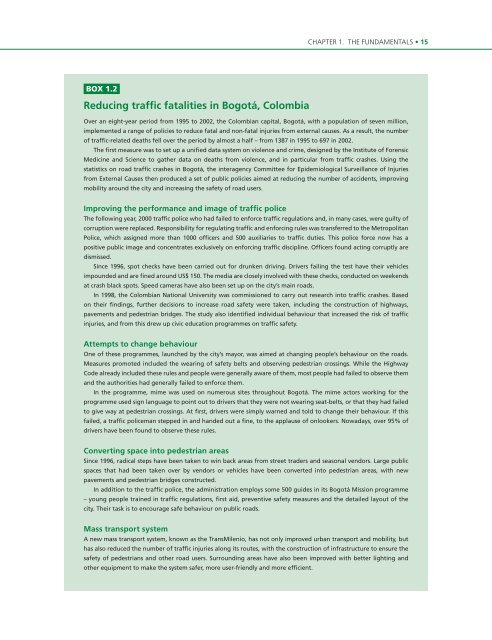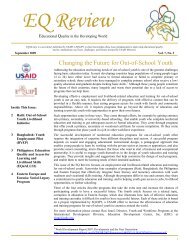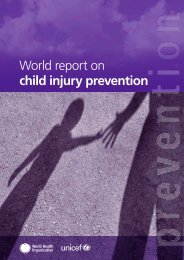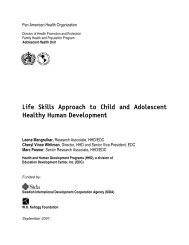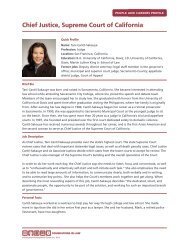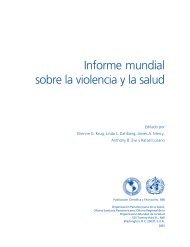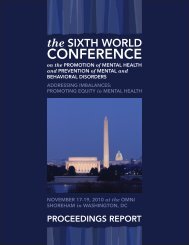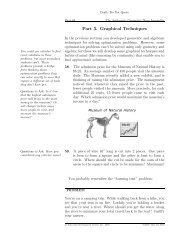World report on road traffic injury prevention edited by M ... - teach-vip
World report on road traffic injury prevention edited by M ... - teach-vip
World report on road traffic injury prevention edited by M ... - teach-vip
Create successful ePaper yourself
Turn your PDF publications into a flip-book with our unique Google optimized e-Paper software.
CHAPTER 1. THE FUNDAMENTALS • 15<br />
BOX 1.2<br />
Reducing <strong>traffic</strong> fatalities in Bogotá, Colombia<br />
Over an eight-year period from 1995 to 2002, the Colombian capital, Bogotá, with a populati<strong>on</strong> of seven milli<strong>on</strong>,<br />
implemented a range of policies to reduce fatal and n<strong>on</strong>-fatal injuries from external causes. As a result, the number<br />
of <strong>traffic</strong>-related deaths fell over the period <strong>by</strong> almost a half – from 1387 in 1995 to 697 in 2002.<br />
The first measure was to set up a unified data system <strong>on</strong> violence and crime, designed <strong>by</strong> the Institute of Forensic<br />
Medicine and Science to gather data <strong>on</strong> deaths from violence, and in particular from <strong>traffic</strong> crashes. Using the<br />
statistics <strong>on</strong> <strong>road</strong> <strong>traffic</strong> crashes in Bogotá, the interagency Committee for Epidemiological Surveillance of Injuries<br />
from External Causes then produced a set of public policies aimed at reducing the number of accidents, improving<br />
mobility around the city and increasing the safety of <strong>road</strong> users.<br />
Improving the performance and image of <strong>traffic</strong> police<br />
The following year, 2000 <strong>traffic</strong> police who had failed to enforce <strong>traffic</strong> regulati<strong>on</strong>s and, in many cases, were guilty of<br />
corrupti<strong>on</strong> were replaced. Resp<strong>on</strong>sibility for regulating <strong>traffic</strong> and enforcing rules was transferred to the Metropolitan<br />
Police, which assigned more than 1000 officers and 500 auxiliaries to <strong>traffic</strong> duties. This police force now has a<br />
positive public image and c<strong>on</strong>centrates exclusively <strong>on</strong> enforcing <strong>traffic</strong> discipline. Officers found acting corruptly are<br />
dismissed.<br />
Since 1996, spot checks have been carried out for drunken driving. Drivers failing the test have their vehicles<br />
impounded and are fined around US$ 150. The media are closely involved with these checks, c<strong>on</strong>ducted <strong>on</strong> weekends<br />
at crash black spots. Speed cameras have also been set up <strong>on</strong> the city’s main <strong>road</strong>s.<br />
In 1998, the Colombian Nati<strong>on</strong>al University was commissi<strong>on</strong>ed to carry out research into <strong>traffic</strong> crashes. Based<br />
<strong>on</strong> their findings, further decisi<strong>on</strong>s to increase <strong>road</strong> safety were taken, including the c<strong>on</strong>structi<strong>on</strong> of highways,<br />
pavements and pedestrian bridges. The study also identified individual behaviour that increased the risk of <strong>traffic</strong><br />
injuries, and from this drew up civic educati<strong>on</strong> programmes <strong>on</strong> <strong>traffic</strong> safety.<br />
Attempts to change behaviour<br />
One of these programmes, launched <strong>by</strong> the city’s mayor, was aimed at changing people’s behaviour <strong>on</strong> the <strong>road</strong>s.<br />
Measures promoted included the wearing of safety belts and observing pedestrian crossings. While the Highway<br />
Code already included these rules and people were generally aware of them, most people had failed to observe them<br />
and the authorities had generally failed to enforce them.<br />
In the programme, mime was used <strong>on</strong> numerous sites throughout Bogotá. The mime actors working for the<br />
programme used sign language to point out to drivers that they were not wearing seat-belts, or that they had failed<br />
to give way at pedestrian crossings. At first, drivers were simply warned and told to change their behaviour. If this<br />
failed, a <strong>traffic</strong> policeman stepped in and handed out a fine, to the applause of <strong>on</strong>lookers. Nowadays, over 95% of<br />
drivers have been found to observe these rules.<br />
C<strong>on</strong>verting space into pedestrian areas<br />
Since 1996, radical steps have been taken to win back areas from street traders and seas<strong>on</strong>al vendors. Large public<br />
spaces that had been taken over <strong>by</strong> vendors or vehicles have been c<strong>on</strong>verted into pedestrian areas, with new<br />
pavements and pedestrian bridges c<strong>on</strong>structed.<br />
In additi<strong>on</strong> to the <strong>traffic</strong> police, the administrati<strong>on</strong> employs some 500 guides in its Bogotá Missi<strong>on</strong> programme<br />
– young people trained in <strong>traffic</strong> regulati<strong>on</strong>s, first aid, preventive safety measures and the detailed layout of the<br />
city. Their task is to encourage safe behaviour <strong>on</strong> public <strong>road</strong>s.<br />
Mass transport system<br />
A new mass transport system, known as the TransMilenio, has not <strong>on</strong>ly improved urban transport and mobility, but<br />
has also reduced the number of <strong>traffic</strong> injuries al<strong>on</strong>g its routes, with the c<strong>on</strong>structi<strong>on</strong> of infrastructure to ensure the<br />
safety of pedestrians and other <strong>road</strong> users. Surrounding areas have also been improved with better lighting and<br />
other equipment to make the system safer, more user-friendly and more efficient.


